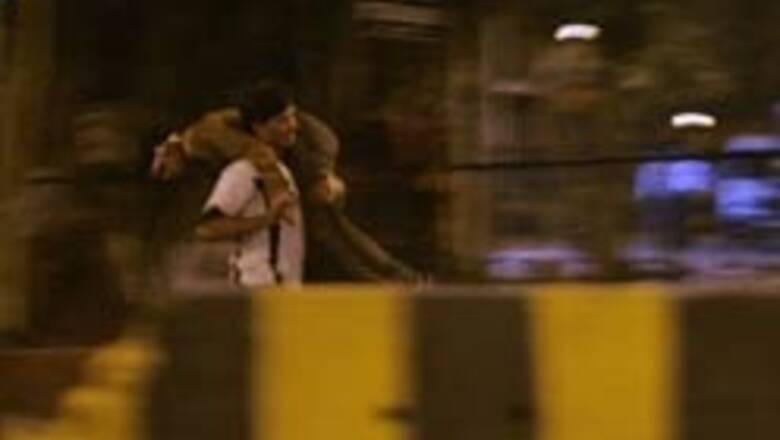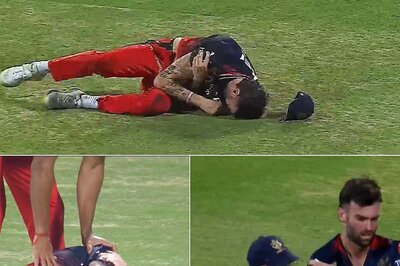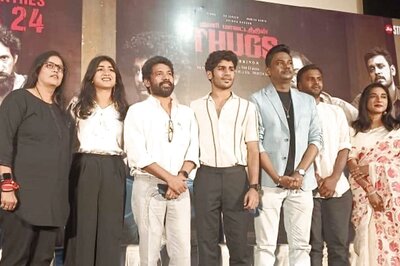
views
Late in the evening on Wednesday, November 26, 2008, Mumbai eventually got its very own 9/11. Watching room after room at one of the most majestic and stately symbols of the city, the Taj Mahal Hotel, go up in flames it was hard not to ask the same incredulous and seemingly naive question, “Why do they hate us?”
11.30 p.m.
I start out at the other side of town from Colaba, at Vile Parle east on the western express highway, where the wreck of the taxi and the fresh red stains on the concrete were being white chalked by the investigating team. It is believed the taxi was heading towards the international airport loaded with RDX when its consignment blew up, killing five including the two passengers (suspected terrorists) and driver. Vijay, a 17-year-old who lives in the hutment by the road, recounts a terrifying sight. He was just sitting down to dinner when he heard the blast. He went out to see and a few steps out of his front door, was greeted with the dismembered head of one of the victims. Vijay has seen his share of calamity during the floods of 26/7/05 and then again during the train blasts of 11/7/06. He states matter-of-factly, this is another date with terror he will never forget.
12.15 a.m.
There are rumours of a hold-up at a suburban hotel, but it turns out to be a hoax call, which nonetheless gets the hotel and the police to sound a red alert in the area. In the meanwhile there are unconfirmed reports of shootouts and casualties in south Mumbai. After a few minutes of deliberating, I jump into a cab with three photojournalists from three different publications who were heading in that direction. Expecting to be stopped at every bend, we keep prepping our taxi driver on do’s and don’ts in case the police stops us. Between non-stop phone calls from colleagues with updates on the escalating battle scene, we caution the driver to slow down to a snail’s speed the minute he sees a red light and stick to the narrow, quiet bylanes instead of the main roads as far as he can. We warn him to stay with his cab at all times. We were reassuring and preparing ourselves for whatever lay ahead. He simply nodded and drove as directed. We made it to Haji Ali without seeing a single police car.
1.45 am.
At Haji Ali, we encounter the first police blockade. They tell us in no uncertain terms that it is dangerous to carry on and demand that we turn back. We turn left towards Nana Chowky and continue towards town. Just then we receive news of a gun-down at Chowpatty. We already have reports that ATS chief Hemant Karkare, additional CP (eastern region) Ashok Kamte and top encounter cop Vijay Salaskar were among those gunned down in an ambush by two terrorists near Azad Maidan a short while ago. The Mumbai police were out to get those who had taken out their best.
At Sukh Sagar, the taxi driver hesitates a brief instant, waiting for some indication that he should turn left. The silence in the taxi is loud enough a sign for him to turn right. He parks at the side of the road and we cautiously approach the carnage in front of us. The Skoda carrying the terrorists who were believed to have killed the Mumbai police top brass is untouched at the front. The bullet holes instead have shattered the glass at the rear. Cartridges, shoes, bloody notes and other debris are being collected for evidence. The cops there have blood stained clothes but they also have their revenge—both terrorists dead. “We will not let our officers’ death be in vain,” says the officer on site. Girguam is also where, in the stillness of the night, watching Mumbai police turn armed weapons at approaching vehicles, we get a real sense of the magnitude of what is happening that night to the city. The city has been scarred before. The city has been gravely wounded before. The city has bled before. How bad is it going to be this time around? Beyond imagination? Most certainly. But then, didn’t we think that in 1993? In 2006?
PAGE_BREAK
2.30 a.m.
We return 15-minutes later from the scene under Girguam bridge to our taxi and again, it is silence that prompts the taxi driver to continue down Marine Drive towards the Oberoi Hotel. We approach Oberoi around 2.45 am. OB vans occupy one side of the street. Ambulances and fire brigade vehicles are on the other side. Joining the media personnel flocked outside the hotel, stories are exchanged on who has been where and seen what. “CST station was the worst. An AK-47 on rampage is the worst nightmare to happen in Mumbai,” says one reporter. No one has any confirmed reports on what exactly is happening inside the hotel. Yes, there are terrorists holed up there. Yes, there are hostages. Firing. The fire brigade personnel are huddled in a group on the parapet at Marine Drive. The medical team is waiting, disposable gloves and masks on. Anxious friends and relatives, guests staying at the hotel who were returning from previous engagements are being calmed by authorities. Shocked cops from the ATS are coming to grips with the loss of Hemant Karkare and others.
3.30 a.m.
By now, our party of four has dwindled to two. We decide to head towards the epicentre. Again to our incredulity, there is no police presence from Marine Drive, down Vidhan Bhavan near Churchgate station until we reach Regal cinema. Our taxi driver says he will park near the museum, insists he will wait for us and for the first time issues a softly spoken, “Be careful.”
3.45 a.m.
We walk down Colaba Causeway and take the first left from Regal cinema to head towards the Taj. I have walked down these streets a few hundred times over the years, at various times of the day and night. I have lived at the adequate Moti Mahal hotel here for a brief month. I have spent many an enjoyable and eventful evening at Leopold Café. The walk from Regal to Taj has never felt so heavy at each step of the way.
The first glimpse of the Taj is serene. The night sky dotted with stars and the impressive vertical lines of the new building and the iconic dome of the old Taj. A few steps more and the floodlights from the fire brigade illuminate the grim reality. The Taj stands pitch black except for the flames licking the top floor of the old building. Gun shots, armoured vehicles, more fire brigade vehicles, ambulances and of course, a sea of journalists. It doesn’t take me long to find my colleague there at the scene. We huddle together with a few other journalists at the Apollo Bunder side of the Taj. From there we have a clear view of the fire brigade personnel attempting to control the flames in a room in the far left corner of the old building. But soon the room after that is seen glowing orange. And then the room after that. Wooden balcony frames, foam mattresses and other combustible material are a perfect recipe for disaster. Glass cracking under intense heat crashes to the ground below. There is no more gunfire. It is all quiet except for the crackling fire. It is all dark except for the glowing embers.
PAGE_BREAK
6.00 am.
At the first sign of day break on November 27, the fire brigade with their elevator ladders swing into action, rescuing harried guests trapped inside the old Taj building. Several of those trapped are brought down to safety, wrapped with white towels and bed-sheets as protection against smoke inhalation. Large hoses are dousing the flames.
We are kept a safe distance away by the police and with our lenses capture the worst disaster to have struck the heart of this city by the bay. As night turns to day, we continue to document and to witness. And yet, it is difficult not to be affected by the heat of the burning Taj. It is difficult not to be affected by the cold bloodedness of the attackers.
7.30 am.
As the fire brigade finishes its operations, we think the worst is over. We are hungry and thirsty and want to carry on with the business of filing our stories and pictures. Making our way towards the Gateway of India side of the Taj we mingle with journalists and police attempting to piece together a cohesive timeline of events. It is a false dawn, the quiet before the storm. Gunshots from the Taj get us running for cover. Retaliatory gunfire from the ground follows.
Over the next few minutes, the army has taken positions. The media is cordoned off. The Gateway of India has snipers strategically placed. The area is declared a no-man’s zone. No one can move. No one wants to. And then one more window in the old Taj is seen glowing.
8.00 am.
The army commandos storm the new building. BEST buses are put into service to transport civilians to safety. More ambulances arrive. Tense anticipation fills the air. An hour later, the first group of rescued civilians emerges from the building, escorted by armed personnel. They make it as far as the side of the road before shots are fired again. They instinctively duck for cover. So do we. A few minutes of anxious silence later they are quietly herded into a waiting BEST bus. An injured person—it is unclear whether he is a civilian or suspected militant—is carried on a stretcher to a waiting ambulance.
Soon a few more civilians are escorted from the hotel. The media get access to some sound bytes from frightened employees. “It was the worst thing I have lived through in my life. I was here on a business trip and my wife decided to accompany me. We were due to leave tomorrow in the evening and return home to Tokyo. Now I have no idea where my wife is and I just don’t know what to do and what to think. I just don’t know…” a Japanese middle-aged man is narrating to a journalist nearby. No one is able to say what really is going on. And then another blast is heard. Eerie silence envelopes the area. And then more army personnel storm into the building.
PAGE_BREAK
12.30 p.m.
Morning turns to noon. It has been quiet for a couple of hours since the last blast. We soon find out why. Everybody makes a beeline for Nariman House, a few streets away. A couple of those being held hostage, including a two-year-old girl, are rescued. But the terrorists are still holed in there with more hostages. Army personnel explain that it is difficult to storm either the Taj, the Oberoi or Nariman House because the safety of innocents being held would be gravely compromised. And so they can only take very small steps at a time to gain a foothold in the garrisons the terrorists have set up.
5.00 p.m.
At the Taj, again more gunfire and soon another room on fire. It seems like the militants have done their groundwork very well indeed. They make very few mistakes. It is surreal to stand and stare at immaculate window dressings of the best luxury names in the business while the top floor of the same building is being gutted.
As twilight descends, the atmosphere is almost relaxed. Rescue operations at the Oberoi have been a success. CST station has been cleaned up and trains were running, albeit sparsely populated. We manage to get a meal.
10 p.m.
We return to the Taj. It has now been 24 hours. Fire still glows. No one has any confirmed figures on how many rescued, how many still trapped, how many terrorists still holed up. We are exhausted. It is time to head home, rest and see what November 28 would bring.
(Aliefya Vahanvaty is chief copy editor with the new business magazine to be launched by Network 18 in alliance with Forbes of USA. )




















Comments
0 comment